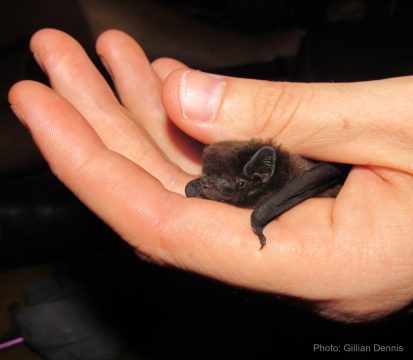Bats in the back garden

Long-tailed bat in hand.
Many people shudder at the thought of bats.
Who’s to blame for this misconception? Was it Bram Stoker who wrote the classic tale of Count Dracula in 1897, or was it the film industry that subsequently embellished the story of the supernatural, blood-drooling vampires?
In contrast the two remaining New Zealand bats are not at all like vampire bats, they are micro bats, and as the name suggests, tiny and very cute. The long-tailed bat is classed as “nationally critical”, while the short-tailed bat subspecies ranges from “nationally vulnerable” to “recovering”.
On mild evenings, and there have only been a few of these, I went for a walk in the hope of seeing pekapeka (long-tailed bats) before darkness fell, but to no avail.
Then, a couple of weeks ago I started a new regime of taking the dog for a second walk at dusk. This first evening was drizzly and the temperature was between 12degC and 14degC. As I was heading out the gate, much to my surprise, because I wasn’t even looking for them, two pekapeka were sweeping just above us in the direction of one of our ponds. Despite the drizzle, there were plenty of insects about and the bats were feeding on the wing.
The next evening was clear and I never saw any bats. Then a day later it was grey, dull and drizzly, and here we go again, I saw one bat. The following night I saw two bats and again it was a dull and a rather fresh evening.
This experience is different from other years when we saw them night after night on mainly balmy evenings. I don’t have any explanation for this change, except for one aspect; I observed that on fine evenings, tui were still chattering and chortling away until around 10pm. All other birds were quiet. Is the chortling of the tui discouraging bats from leaving their roost sites in Talbot Forest?
Pekapeka are expert fliers, and can reach an incredible speed (up to 60kmh) and easily catch insects on the wing. Their wings are made up of long finger bones joined by a thin layer of a translucent membrane.
In search of food they travel up to 15km from their roosts each night. It seems a high number, but they apparently can consume up to 600 insects a night. This seems quite a lot, since they only weigh about 18g.
Does this mean, if we encouraged more bat roosting sites and had more bats, they would reduce the number of species that create harm to horticultural and agricultural crops, such as the grass grub beetle?
Ines Stager is a landscape architect based in Geraldine, a Forest & Bird board member and a committee member of the South Canterbury branch. This article was originally published in The Courier.
